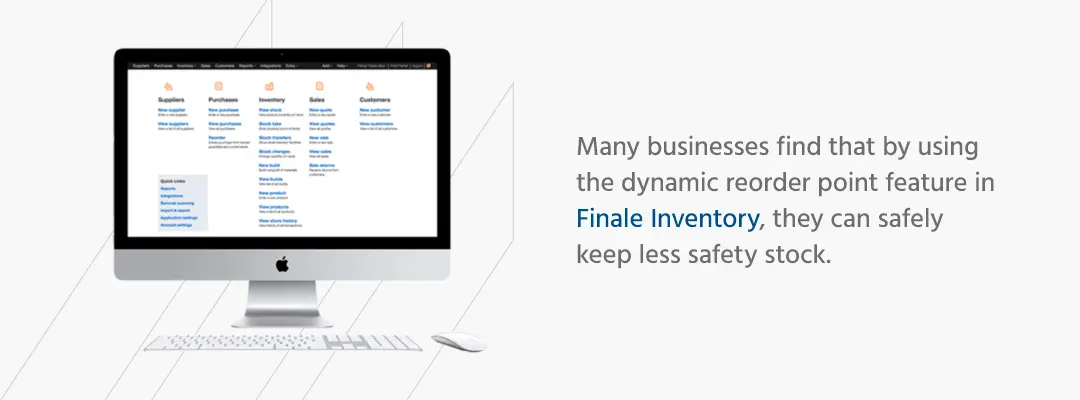Inventory Management Techniques in Operations Management

Inventory Management Techniques to Streamline Your Operations
Various inventory management techniques in operations management are available to you. The different techniques, tools and methods vary in complexity, time commitment and accuracy. Many of these strategies can help you optimize your stock levels and reordering schedules based on mathematical formulas. With so many possible approaches to improve stock management, every company that manages inventory must find the right blend of strategies and methods that work best for their particular industry, company size and unique way of doing business.
For example, third-party logistics providers (3PLs) may have more need for warehouse and inventory handling methods since they manage inventory across many locations for many clients. Meanwhile, businesses in the health and beauty market or the food and beverages industry may need to track their inventory by expiration date. Therefore, they need to prioritize strategies to move their inventory quickly. Consumer electronics brands, with their complex manufacturing and assembly procedures, require a method for tracking raw materials, works in process and finished goods.
These factors can contribute to very different methods for managing inventory — each one specialized to the particular business.
The Need to Be Strategic With Inventory Management Techniques
Inventory management is a precise discipline that relies on keeping just enough inventory to cover demand without holding so much that it unnecessarily increases costs. You must balance the risk of overstocking against the risk of understocking. Also, consider the cost of shipping items from your supplier versus the costs of holding them in your inventory. To manage inventory effectively, you need good data to forecast demand and a reliable system for prioritizing how you divide your time and resources when applying your inventory control and handling methods.
Some of the benefits of strategic inventory management include:
- Better warehouse organization: Good warehouse and stock handling techniques lead to a more organized warehouse. For example, by preventing overstocking, you’ll have more room to dedicate to your highest priority stock. Being able to identify unprofitable and slow-moving inventory better allows you to clean out unwanted merchandise faster. Better warehouse organization contributes to better inventory management, too. When the warehouse is organized, you’ll keep better track of your stock and be less likely to lose or damage products.
- Saved time and money: The right inventory management strategies, especially paired with tools like inventory control software, save you time and money. You’ll spend less time counting physical stock, tracking down inventory discrepancies and working through preventable challenges. By optimizing stock levels, you’ll save storage costs and prevent costly overstocking. You can also earn more revenue by keeping products in stock to take advantage of more sales opportunities.
- Improved customer satisfaction: Having stock when customers want to make a purchase is good for the customer experience. It also prevents you from having to cancel customer orders or place shoppers on waitlists. Adequate stock levels and an efficient inventory handling method also help you meet customers’ expectations for faster shipping.
What Are the Inventory Management Techniques You’ll Learn About?
This guide will provide an in-depth overview of the various methods of inventory control, such as:
- Setting safety stock levels and reorder points.
- Managing relationships with key vendors.
- Planning for contingencies and stock challenges.
- Auditing your stock regularly.
- Using ABC analysis to prioritize stock.
- Forecasting and planning for future demand.
- Managing inventory accounting with the average costing method.
- Reordering stock just in time.
- Managing raw materials and finished product inventory with material requirements planning.
- Calculating optimal stock quantities using the economic order quantity formula.
- Analyzing and prioritizing stock using fast, slow and nonmoving inventory analysis.
We’ll explain these techniques and show you how to implement them in your own inventory management operations. Through this guide, you’ll gain a wealth of resources for how to improve your inventory management system. If you’re looking for a flexible, customizable software solution that can help you manage your inventory more effectively with some of these methods, contact the Finale Inventory team or get started with your free trial today.
Chapter 1: Safety Stock, Par Levels and Reorder Points

Calculating your safety stock and par levels or reorder points are crucial inventory stocking methods. According to a study by Harvard Business Review, a staggering 72% of stockouts in retail stores result from issues with reordering and replenishment. Reordering too little or too late can have a massive consequence on business because running out of stock means you miss sales opportunities.
Whether you’re involved in warehouse or store inventory control, having a precise inventory reordering procedure with the help of a calculated reorder point or par level is crucial. The other 28% of stockouts happen due to issues in the supply chain. The potential for supply chain delays makes having the right amount of safety stock especially crucial. Let’s discuss the mathematical formulas for safety stock, par levels and reorder points to ensure you always have enough supply to meet your regular demand and then some.
What Is Safety Stock?
Safety stock goes by many other names, including buffer stock or “just in case” inventory. Safety stock is a special type of inventory to help a business mitigate the risk of stockouts. It is extra merchandise in addition to what you plan on selling in a given period. Businesses often express safety stock in the number of days, which can be helpful in planning for potential supplier delays.
Safety stock also helps cover your business if there’s a sudden increase in demand. By tracking your sales velocity in real-time and using accurate forecasting, unexpected increases in demand place less of a burden on your inventory. This makes safety stock primarily a means to account for supplier delays. Having the right amount of safety stock is a bit of a balancing act.
What Is a Par Level?
Par level is a similar concept. It represents the minimum amount of inventory you should have on hand to meet your expected demand between replenishments. Your par level is like a soft floor before your quantity reaches zero. When your inventory levels dip below par levels, it is time to reorder.
Reordering at the par level gives you enough time to receive and process new orders from your supplier before your current stock runs out. Your par level should include the quantity you expect to sell in a given inventory cycle, plus a certain amount of safety stock. Par levels are similar to reorder points because both can trigger a procurement manager to reorder merchandise.

What Is a Reorder Point?
While a par level focuses just on the quantity of stock in the warehouse, a reorder point introduces some additional factors. A simple reorder point setting allows you to set minimum and maximum thresholds for your stock. A dynamic reorder point formula balances many factors. It accounts for:
- Current sales velocity, which may change with the time of year.
- Expected yearly growth.
- Supplier lead times and internal processing time.
- Number of days you hold standard inventory or the length of your inventory cycle.
- Number of days you hold safety stock.
- Quantities available for order from your supplier, such as cases of a dozen units.
Taking all these variables into account, your reorder point calculation will give you an exact date and quantity to reorder. If you order replenishment stock by your projected reorder point, your new merchandise will arrive and be processed in your warehouse just in time to replace your regular inventory.
The biggest potential hiccup is if a supplier delay brings their delivery estimates over what you’ve set as the supplier’s typical lead time, which is where safety stock comes in. Many businesses find that by using the dynamic reorder point feature in Finale Inventory, they can safely keep less safety stock.
How Do You Set Safety Stock and Par Levels?
Determining an appropriate level of safety stock for each of your products takes some thought. You’ll first want to consider how often you want your regular inventory to last and how much you typically sell per day in that time frame, along with typical supplier delays. To calculate your safety stock, use the following steps:
- Multiply your maximum daily unit sales by your maximum lead time, in days.
- Multiply your average daily unit sales by your average lead time, in days
- Subtract your average from your maximum.
The basic safety stock formula is (maximum daily sales X maximum lead time) – (average daily sales X average lead time) = safety stock quantity. You can also use a more sophisticated calculation, the safety stock formula with standard deviation, which is more accurate.
Next, you can use your safety stock quantity to determine your par level. If you restock several times a month, add your monthly inventory use to your desired safety stock level and then divide that figure by the number of deliveries per month.
How Do You Calculate Reorder Points?
To calculate your reorder point for a given product, multiply your average daily unit sales by your average lead time and add safety stock. Keep in mind that the lead time should be the length of time from when you reorder to when items become available for you to send to customers. It accounts for both supplier delivery lead time and your internal processing time. Use the following formula to calculate the reorder point:
- Reorder point = (average daily unit sales X average lead time) + safety stock
Reorder Point and Safety Stock Example
Let’s put these formulas into action with a quick example.
Let’s say you sell an average of 30 bottles of sunscreen every day. One time, you sold 75 in a single day. When you reorder from your supplier, it typically takes 5 days to receive and process the delivery. Recently, when demand was at its peak, a supplier delay resulted in a total lead time of 15 days. When we insert these numbers into the basic safety stock formula, we get:
- (75 X 15) – (30 X 5)
- (1,125) – (450) = 675
So, your business needs to keep 675 bottles of sunscreen on hand as buffer inventory. Next, we can use these numbers to calculate a reorder point.
- (30 X 5) + 675
- (450) + 675 = 1,125
So, when your sunscreen stock level reaches 1,125, it is time to reorder.
How Finale Inventory Leverages Reorder Points to Manage Your Safety Stock
Your reorder points and safety stock levels probably require frequent adjustments. Let’s say you sell long-sleeved T-shirts. You’ll probably sell more of them in the fall and winter than you might in the summer. Taking your maximum daily sales for the whole year might mean having too much safety stock in the warmer months while using your average daily sales for the whole year might leave you understocked during your busiest season and overstocked in the summer.
That’s where Finale Inventory comes in. Finale Inventory tracks your sales velocity in real-time and factors your current sales trajectories into a dynamic reorder point calculation. It also factors in your expected yearly sales growth. That means your reorder point is constantly changing in anticipation of your current demand and projected growth, preventing more over-stock and out-of-stock situations.
Our software also monitors your inventory levels in real-time, making it one of the best inventory tracking methods available. Using your sales and purchasing data, Finale Inventory can update your inventory levels automatically. When any item in your warehouse or store reaches its reorder point, you’ll get an alert telling you it’s time to reorder and the quantities you need to order. Learn more about leveraging reorder points in Finale Inventory, and contact us to schedule a demo of all our purchasing and replenishment features.


Get Started with Finale
Our guided implementation during your onboarding will set you on the path to scaled business growth in just two weeks.
Get a demo on the
first call.Pricing is fair and
transparent.Onboarding starts
with a dedicated consultant.
Get a demo on the
first call.Pricing is fair and
transparent.Onboarding starts
with a dedicated consultant.
Your time is valuable. That's why we jump into the software during your first call.
Finale offers competitive pricing because users stay and grow.
Guided implementation during your onboarding to be set for success.




